Optimizing your website for search engines is critical if you want to increase organic traffic from Google’s search results. Local SEO is a subset of SEO that builds off organic results and is tailored to localizing search results. This is why search queries for “leaky roof repair” may produce different results than “leaky roof repair in San Diego.”
Through optimization, you can enhance your site’s local search rankings, leading to increased traffic. Fun fact: over 47.6% of all clicks come from the first three results on mobile (57% of desktop users).
NAP, an acronym for “name, address, and phone number,” is the essential information that identifies a business. Maintaining consistent NAP across the web is critical.
If you’ve changed your business name, phone, or address, it’s a good idea to have a local SEO professional conduct a local citation audit to verify the consistency of your NAP in local and national directories. Although perfection is not always achievable, maintaining a high level of consistency across directories is essential.
Online reviews also play a crucial role in business credibility, with 93% of customers indicating that reviews influence their purchasing decisions. Having a plan to get authentic feedback is critical, and positive reviews should not be the only focus. Encouraging customers to give authentic, specific feedback can lead to a better experience and help the business improve.
Content creation is an essential tactic to improve SEO and is not limited to blogging. Videos, podcasts, white papers, and other forms of content marketing can be highly effective in reaching an audience and building a brand. Adding links back to your site can increase organic traffic.
To summarize, maintaining NAP consistency, having an online review strategy, and producing quality content are all critical parts of a successful SEO campaign.



